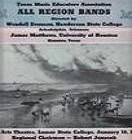
THIS DEPICTS THE MAJESTY AND SPIRITUAL INNER NATURE OF THE ANCIENT CITY OF YEREVAN AT THE FOOT OF MOUNT ARARAT. COMPOSED BY ALAN HOVHANESS WHOSE MUSIC IS ALWAYS POSITIVE, UPLIFTING, NOURISHING. FROM MY H.S. FRESHMAN YR., TMEA REGION X ALL REGION BAND
highschool bands
jazz bands
college bands
all region bands
community bands
concert bands
honor bands
interlochen arts academy
marching bands
national music camp
tmea all state bands
university bands
Story behind the song
Alan Hovhaness (March 8, 1911 - June 21, 2000) was an American composer of Armenian and Scottish descent.
This briefwork for winds and percussion depicts the majesty and spiritual inner nature of the ancient city of Yerevan at the foot of Mount Ararat, the home of many Armenians who found safety from persecution there. An exotic contrapuntal hymn, in the fifth mode "kimtza" of the Armenian church, is stated in the first section with brass, tympani and bells. A middle section with open rhythms of bells and rolling tympani and 3 trombones (with glissandi and in dissonant counterpoint) "celebrates a dauntless defiance of tragedy" (Hovhaness). The final section is a recapitulation of the hymn of the first section, fuller and "triumphant". A stirring and mysterious work with direct emotional appeal.
Alan Hovhaness was a highly prolific composer, with 65 symphonies at the last count and Opus numbers in the 400s, He is well worth investigating. Having arrived at a similar crisis point in his work as Arvo Part, John Tavener and Henryck Gorecki, except much earlier in 1940, his works bear comparison but are richer, with a more inclusive orchestral brush, and more spiritually poetic.
Hovhaness' music is always positive, uplifting, ennobling and spiritually nourishing. He often introduces unusual meters whilst his music is largely modal and always tonal. Nevertheless, within these self-imposed boundaries he allows himself tremendous creative freedom. To give some idea of what his music sounds like one could say that the harmonies of some of his music from the 1970s onwards bears a superficial resemblance to that of the English composer Vaughan-Williams.
Alan Hovhaness Chakmakjian began his new direction in music with the development of his ancient Armenian heritage and then extended his research into music of India and the Far East. In 1959 he received a Fulbright grant as a Research Scholar to study the Carnatic system of music in South India, and in 1962 a Rockefeller grant to study the ancient court and ceremonial music of the Far East - Gagaku, Bunraku, and Chicuen Biwa in Japan and Ah-ak in Korea. Part of his reasons for doing so lay in his conviction that such work offered a clue to European music during the time of the troubadours. A penchant for baroque musical techniques helped him to find a firm organising principle for material and procedures that might otherwise grow amorphous through extended use. As the composer Henry Cowell stated, it is as though he had skipped the 18th and 19th centuries. His spiritual teacher was Hermon DiGiovanno, a Greek mystic painter. In 1943, DiGiovanno guided him into the ancient world of Armenia, Greece, Egypt and India. Later Masatoro Togi, a great Gagaku musician of Japan, became his teacher who taught him to play ancient Japanese music and instruments. This detailed analysis and study of 7th century Armenian religious music, classical music of South India, orchestral music of Tang Dynasty China, Ah-ak of Korea, and Gagaku of Japan, revolutionised Hovhaness' approach to his own composing.